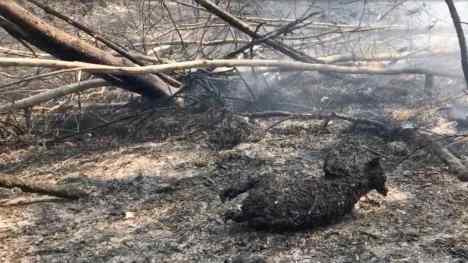Koalas ‘functionally extinct’ after Australia bushfires destroy 80% of their habitat!
Toni Doherty, the woman who rescued a badly burnt and wailing koala from an Australian bushfire was reunited with the koala now known as Lewis on Wednesday (November 20) at the Port Macquarie Koala Hospital.
Doherty told local broadcaster Network Nine that it was ‘just natural instinct‘ for her to rush to Lewis’ aid, wrapping the animal in her shirt and a blanket and pouring water over it.
At the hospital, Clinical director Cheyne Flanagan said he was badly burnt but was on fluids, oxygen, eating and enjoying the five-star service.
The koala populations around Port Macquarie have been a major victim of the flames, with more than 350 of the marsupials feared killed in a major habitat.
As Australia experiences record-breaking drought and bushfires, koala populations have dwindled along with their habitat, leaving them “functionally extinct.”
The chairman of the Australian Koala Foundation, Deborah Tabart, estimates that over 1,000 koalas have been killed from the fires and that 80 percent of their habitat has been destroyed.
“Koala Conservation Australia” President Sue Ashton told the “Sydney Morning Herald” on Monday: “We think most of the animals are burned – it’s a huge cremation, like in a crematorium. They burn sitting in the trees. “
However, some researchers call into question whether koalas are actually functionally extinct, noting how difficult it is to measure total koala populations and populations could be a much larger than estimated by the AKF.
Recent bushfires, along with prolonged drought and deforestation has led to koalas becoming “functionally extinct” according to experts.
 In Australia, a heat record of 125 years ago is expected to be broken
In Australia, a heat record of 125 years ago is expected to be broken
Functional extinction is when a population becomes so limited that they no longer play a significant role in their ecosystem and the population becomes no longer viable.
While some individuals could produce, the limited number of koalas makes the long-term viability of the species unlikely and highly susceptible to disease.
Deforestation and bushfires destroy the main nutrient source of koalas, the eucalyptus tree. An adult koala will eat up to 2 pounds of eucalyptus leaves per day as its main staple of nutrients. While eucalyptus plants will grow back after a fire, it will take months, leaving no suitable food source for koalas and starvation a likely scenario for many.
Many are urging the Australian government to enact the Koala Protection Act, written in 2016 but never passed into law and molded after the Bald Eagle Protection Act in the U.S. The Koala Protection Act would work to protect habitats and trees vital to koalas as well as protect koalas from hunting.
Recent viral videos of Australians rescuing koalas has led to increased donation to support hospitalization and help for burned koalas.
To draw attention to these threats, the ” Australian Koala Foundation” calls for the “Save the Koala” month each September.
The aim should be to raise people’s awareness of the issue and to persuade them to do something about the destruction of plant and animal life.
The Port Macquarie Koala Hospital setup a Go Fund Me page seeking donations to help the hospital treat injured koalas. To date, they have raised $1.33 million, well over their $25,000 goal. This comes from over 30,000 donors.
https://www.forbes.com/sites/trevornace/2019/11/23/koalas-functionally-extinct-after-australia-bushfires-destroy-80-of-their-habitat/#51cdaca27bad
My comment: The fire department had already warned in April.
Twenty-three former fire chiefs and chiefs of action published a letter cautioning the government against “increasingly catastrophic extreme weather events.”
They demanded a meeting that was rejected by the government.
Deputy Prime Minister Michael McCormack even outrageously went so far as to dismiss climate change completely as a web of “crazy, inner-city leftists.”
“We have always had a fire in Australia,” he told media representatives.
Australia is known for its lack of environmental protection. Time and again, the government is being asked to do something about environmental protection, especially since Australia is suffering the most from the effects of climate change.
Australia has over 160 million sheep and 24 million cattle – so it does not take much imagination to understand what these millions of animals can do to the fragile ecosystem of dry soil.
Anyone who has ever traveled through Australia has seen it with their own eyes.
The agricultural lobby is also very strong in Australia, as the first pillar of Australian agriculture is sheep farming, followed by cattle breeding.
Industrial agriculture needs a lot of water, so large dams are built to drain the rivers in Queensland.
They not only pump water from the rivers, they also pollute it with their pesticides and other chemicals.
What if the last water reserves are running out, the rivers are dehydrated or so polluted that any life is impossible ?
Nowhere is it more evident than in Australia.
The earth is burning and we are the culprits.
My best regards to all, Venus
Filed under: GENERAL NEWS - International / National / Regional |








We, humans are responsible and guilty.